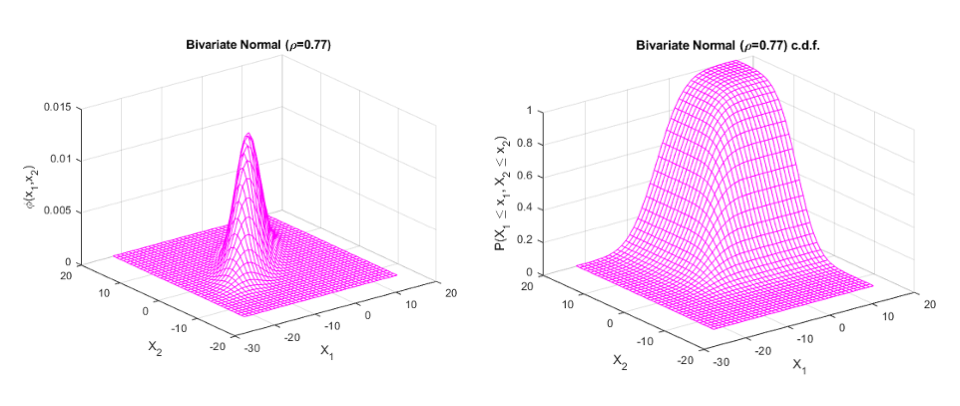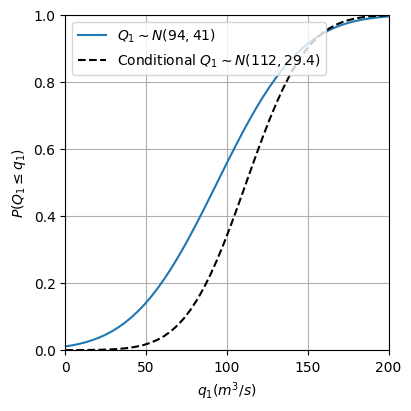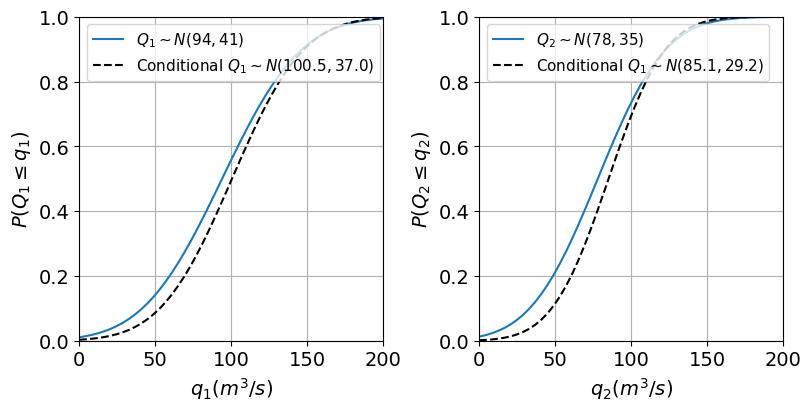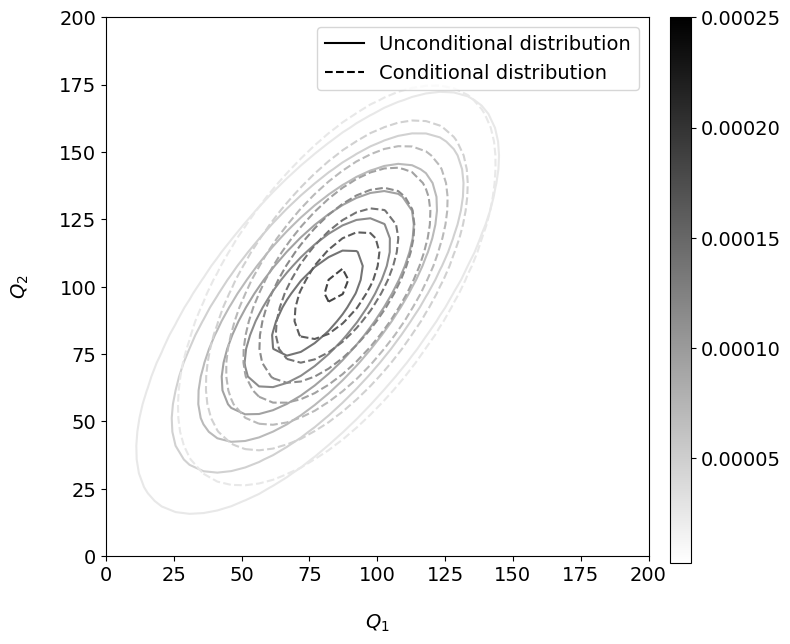6.3. Gaussian distribution#
One of the simplest approaches we have to define a multivariate distribution, \(F(x, y)\), is through the multivariate Gaussian distribution. This model assumes that both the marginals and the dependence are Gaussian. As you saw in previous chapters, the Gaussian distribution is not always the best model so the applicability of the multivariate Gaussian is limited. However, it is a convenient model since it can be manipulated analytically and we can use it as a first approach to model the dependence.
Definition of bivariate Gaussian distribution#
The bivariate Gaussian distribution for two random variables \(X_1\) and \(X_2\) is defined as
where \(x_1\) and \(x_2\) are values of the random variables, \(\sigma_1\) and \(\sigma_2\) are the standard deviations of the random variables, \(\rho\) is the correlation coefficient between \(X_1\) and \(X_2\), and \(\mu_1\) and \(\mu_2\) are the mean values of the random variables. Therefore, it has five parameters: \(\mu_1\), \(\mu_2\), \(\sigma_1\), \(\sigma_2\) and \(\rho\).
We can rewrite the above expression in matricial form as
where \(Cov(X_1, X_2)\) is the covariance of the random variables \(X_1\) and \(X_2\). We can also present the above form in a compressed fashion as
where \(\boldsymbol{x}\) is the vector of values of the random variable, \(\boldsymbol{\mu}\) is the vector of means, and \(\boldsymbol{\Sigma}\) is the covariance matrix[1].
The cumulative distribution function of the bivariate Gaussian distribution would then be defined as
Note that when talking about the Gaussian distribution instead of using \(F_{X_1,X_2}(x_1,x_2)\), we use \(\Phi_{X_1,X_2}(x_1,x_2)\), but it means the same!
In the figure below, you have the PDF and CDF of a bivariate Gaussian distribution for a correlation coefficient \(\rho=0.77\).

Fig. 6.10 Bivariate Gaussian distribution: (left) probability density function, and (right) cumulative distribution function.#
Also, you can plan with the interactive element below changing the correlation value yourself. Observe how the distribution’s density contours, or a scatter plot of samples, change when you adjust the correlation.
Fig. 6.11 Interactively change the correlation coefficient to visualize the effect on density contours or samples of the bivariate Gaussian distribution.#
Conditionalizing a bivariate Gaussian distribution#
Multivariate Gaussian distributions are useful because we can derive results analytically. Here, we are going to conditionalize a bivariate Gaussian distribution to exemplify it.
Given that we are modelling the joint probability distribution of \(X_1\) and \(X_2\) using a bivariate Gaussian distribution and we know \(x_2=a\), what is the expected distribution for \(X_1\)?
An important property of the multivariate Gaussian distribution is that if two sets of variables are jointly Gaussian, then the conditional distribution of one set conditioned on the other is again Gaussian. Thus, the conditional distribution of \(Q_1\) given the value of \(Q_2\) will be a Gaussian distribution whose mean value (\(\hat{\mu}\)) and standard deviation (\(\hat{\Sigma}\)) we need to estimate. This is, we want to compute \((x_1|x_2=a)\sim N(\hat{\mu}, \hat{\Sigma})\). We can derive expressions for \(\hat{\mu}\) and \(\hat{\Sigma}\) applying the definition of conditional density \(\phi(x_1|x_2=a)=\frac{f_{Y_1,Y_2}(y_1, a)}{f_{Y_2}(a)}\) knowing that \(f_{Y_1,Y_2}\) is a bivariate Gaussian distribution and \(f_{Y_2}\) is a univariate Gaussian distribution, replacing \(x_2\) by \(a\) and doing the (unpleasant) algebra. By doing so, we would reach the following expressions
where \(a\) is the known value of \(X_2\) (here, \(Q_2\)) and \(\boldsymbol{\Sigma}=\begin{pmatrix} \Sigma_{11} \ \Sigma_{12} \\ \Sigma_{21} \ \Sigma_{22} \end{pmatrix}\).
Let’s go now back to the example of the discharges of two neighboring rivers, \(Q_1\) and \(Q_2\). We have historical measurements for both discharges and we want to apply a bivariate Gaussian distribution to model their joint distribution. Using the historical dataset, we can compute their mean values, \(\mu_1=94 m^3/s\) and \(\mu_2=78 m^3/s\), their standard deviations, \(\sigma_1= 41 m^3/s\) and \(\sigma_2=35 m^3/s\), and the covariance between them, \(Cov(Q_1, Q_2)=1000 (m^3/s)^2\). We know that \(q_2=100 m^3/s\). What is then the expected distribution for \(Q_1\)? This is, we want to compute \((q_1|q_2=100m^3/s)\sim N(\hat{\mu}, \hat{\Sigma})\).
We can summarize the above information as
Using the above expressions to our examples, we obtain
The figure below displays the difference between the univariate distribution of \(Q_1\) and the conditional distribution of \(Q_1\) given \(q_2 = 100 m^3/s\).

Fig. 6.12 Distribution of \(Q_1\) and conditional distribution of \(Q_1\) given \(Q_2\). .#
From 2D to 3D: multivariate margins#
Often in the fields of Civil Engineering and Geosciences, we want to model more than two variables. Sometimes even tens or hundreds of variables. Thus, we need to find flexible models that account for the probabilistic dependence between them the best way possible. One option is to extend the bivariate Gaussian distribution to a multivariate Gaussian distribution with the desired number of random variables. Note that this implies that all the random variables are Gaussian-distributed.
We can extend the analytical equation to conditionalize the bivariate Gaussian distribution to the 3D multivariate Gaussian distribution to compute \((x_1, x_2|x_3=a)\sim N(\hat{\mu}, \hat{\Sigma})\) as
Let’s see an example with three dimensions. Imagine that we want to model the dependence between the precipitation, \(P\), and the discharges of the two rivers, \(Q_1\) and \(Q_2\). From a raingauge station, we could obtain the needed statistics of \(P\) to model it using a Gaussian distribution, \(\mu_P=12mm/h\) and \(\sigma_P=27mm/h\), as well as the covariance with \(Q_1\) and \(Q_2\), \(Cov(P, Q_1)=475\) and \(Cov(P, Q_2)=520\). Assuming that we model the joint distribution of \(P\), \(Q_1\) and \(Q_2\) using a multivariate Gaussian distribution, its parameters would be
Now we want to make use of the multivariate Gaussian distribution to see what is the distribution of the discharges in the river if today is raining \(p = 22mm/h\). This is, we are going to conditionalize the 3D multivariate Gaussian on one variable, \(P\), to obtain a conditional bivariate Gaussian distribution of \(Q_1\) and \(Q_2\). In mathematical terms, \((q_1, q_2|p=22mm/h)\sim N(\hat{\mu}, \hat{\Sigma})\). We would do it as
We can see that the means of the random variables \(Q_1\) and \(Q_2\) have increased while \(Cov(Q_1, Q_2)\) has been reduced from 1000 to 661.2. The figure below displays the difference between the univariate distributions of \(Q_1\) and \(Q_2\) without and with conditionalizing.

Fig. 6.13 Unconditional and conditional Gaussian distributions given \(P\): (left) \(Q_1\), and (right) \(Q_2\).#
We can also compare the bivariate Gaussian distribution of \(Q_1\) and \(Q_2\) without and with the conditionalization, as shown in the Figure below. You can see how the mode of the distribution (point of maximum density) has moved towards the upper right side of the plot and become slightly narrower when conditionalizing.

Fig. 6.14 Unconditional and conditional bivariate Gaussian distributions for \(Q_1\) and \(Q_2\). Same density contours are plotted for both distributions.#
Extra material: a video#
If you need to refresh the concept of covariance and correlation and want to see a short video on the multivariate Gaussian distribution, you have one here!
Attribution
This chapter was written by Patricia Mares Nasarre and Robert Lanzafame. Find out more here.
